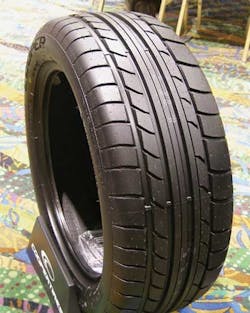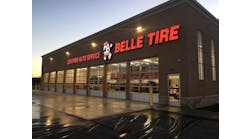The top five UHP sizes don’t even fit sports cars. They fit sedans.” That telling comment from Rick Brennan, vice president of marketing for Kumho Tire U.S.A. Inc., speaks volumes about the evolution of the ultra-high performance tire segment of the market.
Twenty-five years ago, there were four categories in the performance segment: ultra-high performance, high performance, performance and cosmetic. There were no touring tires, and winter tires were only known as snow tires. The all-season tire segment was calculated separately.
Today, there are no fewer than six categories, at least as they apply to traditional summer tires. For an apples-to-apples comparison of performance then and now, we will stick with tradition. Be aware that there is a lot of overlap between not only categories but also within segments (there are UHP winter tires, for example).
The Tire Rack breaks down summer passenger performance into extreme, max, ultra-high, high, grand touring and DOT track and competition. Tire Rack is credited with creating the max performance category.
“Max is what UHP used to be in 1985,” says Brennan, who refers to the present UHP category as more of a “value UHP.” Original equipment tires on sports cars such as the Porsche 911, or a Corvette or Ferrari are max performance tires.
Extreme performance is the latest addition to the summer UHP tire segment. These tires feature “race-like compounding,” says Brennan. The Falken Azenis Sport RT-215 was one of the first extreme performance tires on the market.
According to Tire Rack, extreme performance tires are designed for customers who want extreme dry street performance and are willing to trade some comfort and hydroplaning resistance to get it. “Extreme is pushing it way past normal,” says Brennan. “It is geared toward dry performance, for high horsepower cars that have the best of everything.”
Modern Tire Dealer recently sat down with Brennan to talk about his views on the evolution of performance tires in general, and UHP tires in particular.
“UHP used to define a segment. Now it defines a speed rating,” he says. “And that doesn’t mean anything to the consumer. That’s why you are seeing all these mini-segments cropping up.”
[PAGEBREAK] Appearance vs. performance
In 1985, MTD defined a cosmetic performance tire as having no “speed” ratings (S- or higher). “They are less expensive than their respective performance counterparts, but have the look of performance-enhanced tires.
“Their construction and tread design features do not qualify them as true performance tires.”
An example of a cosmetic performance tire was the El Dorado Custom Stock 60-series bias brand. “There are many 70-, 65-, 60- and even 50-series, raised white letter tires in this category,” we wrote.
“The 75-series, white sidewall, all-season radials are not considered cosmetic performance tires. Neither are most of the 70-series, white sidewall tires of the same type.”
“Back in 1985, you could define UHP by the car, like the BMW M-Series or the Corvette,” says Brennan. “There were no more than 16 to 20 sizes, ranging from 195/50R15 up to 275/40R17.
“Cosmetic was still a performance tire, mostly 60 series, 15- inch tires. A 1957 Chevy with the big tires on the back, or a 1962 Chevy Impala came with cosmetic performance tires on them. They didn’t have great grip, but they were physically wide.”
Fast forward to the early 1990s, when the import tuner craze started to take off. To tuner car owners, the look of the tire was much more important than its performance.
“Honda Civic owners wanted big wheels, so they started plus-sizing. They needed size 205/40R17 and 215/40R18 tires for the look they wanted, but nobody made those sizes in a cosmetic tire. They were only available in UHP sizes.”
The result, says Brennan, was that UHP tires became, for all intents and purposes, cosmetic tires.
Plus sizing led to an increase in shipments of larger sizes, first 225/40R18, then 215/35R19, then 225/30R20. At the same time, traditional V- and Z-rated UHP sizes were being offered with H ratings.
As the SKUs and shipments increased, so did the price range.
“In the early 1990s, the price point zone for UHP tires started to stretch,” says Brennan. “The top selling UHP size in 1985, 225/50R16, was sold to dealers for between $120 and $250. In 1995, that same tire size was sold anywhere from $55 to $250.
“That led to new technology, and the flagship tires evolved. And the max performance category was created.”
Brennan says he has seen a 205/40R17 tire manufactured in China sell for as low as $30 here in the U.S.
[PAGEBREAK]
Turn of the century
From 2001 through 2010, domestic shipments of high performance tires, defined as sizes H-rated and higher, 70-series and lower, have grown more than 130%. Ultra-high performance tires, in general V-rated sizes and higher, account for a significant part of that increase.
The UHP market segment has grown nearly 250% in the last 10 years, from 7.5 million units to 26 million.
Those numbers are a little misleading, says Brennan, because they are based solely on size and speed rating, not usage.
Vehicle evolution is partially responsible for the confusion.
At the same time plus sizes were being developed for Cadillac Escalades, Ford Explorers and Toyota Camrys, technology for vehicle engines evolved. For example, the Ford Grenada in 1980 and the Toyota Camry in 2010 represent the same basic vehicle segment. However, the OE tires on those vehicles are night and day different.
“The OE manufacturer has to put on a tire that’s equal to the capability of the vehicle, which might be 130 mph,” he says. “Eventually, you will see an 80,000-mile tire with a V-speed rating. So you see how the UHP segment has become so cloudy.”
The top five most popular UHP sizes are: 225/50R17, 215/55R17, 215/50R17, 215/60R16 and 225/45R17. The 225/50R17 can be found on not only police pursuit vehicles, but also the Ford Fusion!
The most popular “true” UHP tire is sixth on the list: 225/45R17, which fits on a Subaru WRX.
Rounding out the top 10 are 235/55R17, 205/50R17, 205/60R16 and 215/45R17. There are 10 17-inch sizes in the top 20, but only one 15-inch size (195/55R15 at number 20).
Brennan says the UHP tire lines will continue to blur, because sports car sizes are either growing slowly or declining, and sedan sizes are getting larger.
“The vehicles that came with size 235/75R15 10 years ago are coming out with 17-inch versions now.
“Size 225/45R18 is going to continue to grow, as are 17-inch, 50- and 55-series tires. Eighteen- and 19-inch, 55-series sizes are growing as well, especially because they come on CUVs (crossover-utility vehicles).”
That doesn’t bode well for size proliferation, even though companies like Falken Tire Corp., Hankook Tire America Corp., Yokohama Tire Corp and Toyo Tire U.S.A. Corp. “have cut back on sizes like us. In some lines, the number of tire models we offer the same size in is increasing.
“Probably the biggest single issue is SKU count,” says Brennan. “And it’s not going to get any better.”
(For the High performance tire brand chart, 2010, click here.)




